“Century-Old Assembly Hall Is Renovated,” Ensign, Feb. 1983, 70
Century-Old Assembly Hall Is Renovated
A hundred years ago, President Joseph F. Smith of the First Presidency stood at the pulpit of the newly completed Assembly Hall on Temple Square and dedicated the building. “May the Spirit of the Holy Gospel,” he prayed, “dwell in the midst of the people that shall come from Sabbath to Sabbath, and from time to time, to attend the meetings and worship in this house.” (Journal History, 7 Jan. 1882.) Within a month or two, that same Assembly Hall will be completely renovated and restored to its original grace and beauty in every detail.
During the past three years, this historic building has undergone a methodical transformation from an aging fixture on Temple Square to an elegant, aesthetically pleasing yet functional meeting hall for worshippers and cultural enthusiasts alike. Its association with Church history makes it interesting to all Latter-day Saints, while present-day technology has rendered it an edifice of many and varied uses.
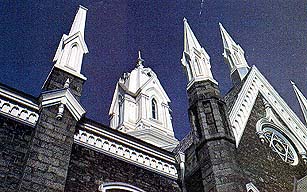
Center tower was repaired and repainted, pinnacles capped with fiberglass replicas of the originals. Flat-topped spire at left designates location of early chimney flue. While actual flue no longer exists, architects have preserved building’s original appearance in detail.
It was not always known as the Assembly Hall, nor was it the first structure to occupy the southwest corner of the temple block. On this site, not long after the pioneers’ arrival in the valley, was erected the Bowery, a series of poles and braces supporting “an immense quantity of leafy branches of trees, which composed the roof and served to shelter the congregation of earnest worshippers from the rays of the summer sun.” Millennial Star 42, 26 April 1880, pp. 264–65.) Nearby, to accommodate gatherings of the Saints in less-than-ideal weather, an adobe “Tabernacle” was built. (This structure was referred to as the “Old Tabernacle” after the present Tabernacle was completed.)
The Assembly Hall was Brigham Young’s idea. According to historical records, “at a priesthood meeting of the Salt Lake Stake, held August 11, 1877, President B. Young proposed to pull down the Old Tabernacle, and build a new one to accommodate about 3,000 people.” (Journal History, 12 Sept. 1877.) The building would be used primarily for meetings of the Salt Lake Stake. Although President Young died only eighteen days after making the proposal, stake officials caught his vision and work was begun immediately to raze the old tabernacle and begin the Assembly Hall. The completed building was dedicated in January of 1882.
A Salt Lake City newspaper offered an added rationale for construction of the Assembly Hall: “Inability of early Salt Lake City engineers to heat the tabernacle [the building now on Temple Square] on cold winters days necessitated construction of the bepinnacled assembly hall. …
“Sunday afternoon services in the tabernacle were then the highlights in otherwise workaday weeks for thousands of city residents and country visitors who thronged the sessions.
“In the winter, however, the vast interior of the tabernacle defied the heating equipment and the chill kept audiences uncomfortable.” Salt Lake Telegram, 4 Apr 1934.) The Assembly Hall’s smaller size and steam heating system also made it a comfortable choice during general conference weather; in 1882 the Deseret News reported that “President [John] Taylor said as the weather continued cold and we were unable to warm the Tabernacle, Conference would meet this afternoon in the Assembly Hall at 2 o’clock P.M. If the weather was warmer on Saturday, we would meet in the Tabernacle, when all should come well clothed.” Deseret News, 6 October 1882.)
Through the years this “bepinnacled” hall, modified gothic in architectural design and characteristic of many stake “tabernacles” constructed in the late 1800s, has accommodated overflow general conference crowds, stake conference sessions, lectures, concerts, and a variety of other gatherings. Periodic refurbishings of the building’s exterior and interior have kept the structure in adequate repair. But only with the recent, intensive three-year renovation project has the full majesty of the Assembly Hall been restored.
Project architect James F. McCrea, working under the direction of the late N. Eldon Tanner of the First Presidency, the Presiding Bishopric, and Church architect Emil B. Fetzer, has lovingly and painstakingly supervised the renovation. “This has been one of the most exciting things in my whole life,” says the man who has orchestrated the project. “Anticipating this undertaking, I tried to appreciate the attitudes of our pioneer forefathers, and really comprehend the deep love and devotion they had in making this building a monument—not to themselves, but to the Church and to the Lord. I’ve tried to carry through that feeling in everything we’ve done.”
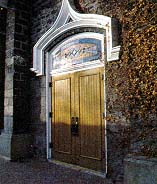
Solid oak doors, delicate stained glass remind Assembly Hall visitors that both pioneer sturdiness, artistic sensitivity played important roles in the lives of early Latter-day Saints.
“The Assembly Hall,” observes Brother Fetzer, “is one of the very precious buildings of the Church; it’s a real treasure. In all the designing and work we’ve done on it, we have tried to keep in mind that this is a Church building of extreme importance, and have tried to keep it to the style of the period when it was built. We’ve preserved as many of the original parts of the building as we could, removed items that have been added in intervening years, and brought the building back as close to the original design as possible. Our prime consideration was what we could do to make it serviceable for this day and age, and still maintain the original concept of the architect and builders.”
Making the building “serviceable” included just about everything. Outside, there was a new roof; deteriorating wood in the center tower was replaced, and the tower repainted; the roof’s twenty-four pinnacles were capped with new, white, fiberglass spires, molded in the exact form of the originals. Circular art glass windows, featuring the six-pointed Star of David, were installed above each of the building’s four doors. (All other windows contain the original stained glass, which was also renovated during the project.)
Inside, the changes were even more dramatic. Pews and flooring were removed, and a spacious basement area constructed beneath the main auditorium. The building’s original wood flooring, which had seen better days, was replaced with new wood. A performing area at the building’s west end was remodeled. Benches were then replaced in their original positions; all wood surfaces had been regrained and refinished, and the stately pillars remarbled to reflect their original appearance.

Remarbeled pillars, regrained benches enhance Assembly Hall’s authentic interior furnishings.
Robert L. Heywood, assistant manager of construction in the Temples and Special Projects division, supervised the construction. “To try and restore the old building,” he recalls, “we attempted to save as many of the old logs that they used for the floor as possible. Underneath the organ area we left the original logs. They averaged in size from eight to fourteen inches in diameter—whole logs just laid out horizontally.” Over time the logs had become brittle and hardened—“like steel,” according to Brother Heywood, “and the superintendent (Irvine Perkins of Layton Construction Company) said that in cutting them he went through several chain saw blades. He had to cut them to adapt to the new construction.”
Even before the renovation project got underway, a major concern developed, originating in the attic. “We were worried about the roof,” muses Brother McCrea. “In July of 1979 our maintenance division discovered that we had huge wooden trusses up there that had some structural problems and needed repair.”
Assigned to work on the problem was structural engineer Boyd Larsen of the Church’s Building Division. Under his supervision, construction crews installed steel support columns reaching from underground footings to within inches of the ceiling. Holes were cut in the ceiling; beams and jacks were then positioned to transfer the load from the trusses to the columns. The roof trusses were shored up and reinforced with steel, then the supporting steel columns were removed. Also installed were a new concrete girth beam around the building and a plywood diaphragm over the top of the ceiling.
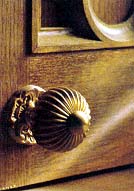
Ornate knobs decorate wooden shutters on Assembly Hall windows. Drapes were replaced by oak shutters to enhance interior decor.
The finished interior of the restored Assembly Hall is a study in attention to artistic detail. From the soothing, subtle shades of rose and green trim, to the twenty-three-karat gold leafing, to the intricate ceiling stencils, to the rich oak and oak-grained woodwork—decorations meticulously applied by artisons Alfred R. Nabrotzky and Arnie Roner—all is designed to reflect the masterful workmanship of pioneer days gone by. “Our pioneer forefathers did things that we absolutely can stand back and marvel at,” says Brother McCrea.
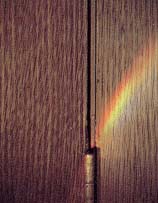
Wood-grained doors match original woodwork as closely as possible, complement building’s warm interior.
The pipe organ, now being assembled, adds both visual and musical dimensions to the hall. Its hand-carved adornments symbolize Latter-day Saint culture and beliefs—the sego lily; the beehive; sheaves of wheat; the sticks of Joseph and Judah; and others. And the organ’s magnificent pipes will soon make, as the psalmist has said, a “joyful noise unto the Lord.” (Ps. 98:4.)
Originally acquired in commemoration of the Church’s Sesquicentennial year, the organ was shipped to Salt Lake City some time ago but could not be installed until the Assembly Hall renovation was completed. At work on the organ’s assembly now are organ designer and builder Robert Sipe and his wife Susan, who moved with their children from Dallas, Texas several months ago to undertake the project.
Tabernacle organists Robert Cundick and John Longhurst describe the process used to select an organ builder. “As members of a committee of Church musicians, we listed a few individuals unanimously considered to be worldclass builders. Then we did some traveling to play recent installations of these builders.
“Our selection of Mr. Sipe was, first and foremost, for the meticulous care that he exercises in voicing; that’s the adjustment of each individual pipe so that it sings—and his pipe work does sing. There are many pipe organs that do not sing; but we wanted a singing organ.”
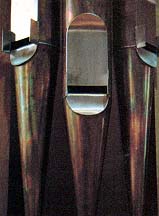
Each of the Assembly Hall organ’s 3,501 pipes has been individually “voiced”—adjusted by organ builder Robert Sipe to produce the desired total quality.
Brother Cundick reflects on the selection of the organ itself. “It was essential that we select an organ that would complement the Tabernacle organ, while maintaining its own individuality and integrity.”
“Both instruments are very eclectic,” adds Brother Longhurst, “in that they will perform with credibility a wide variety of organ literature, accompany congregational singing, and choirs, and soloists. Not all contemporary organs do that, nor are they designed to do that. But we had to have that capability because of the diversity of musical performances that we’ll have in the Assembly Hall.”
Permanent musical instruments in the building will also include a concert grand piano and two harpsichords, all custom-made by William Dowd of Cambridge, Massachusetts. The basement area houses three organ practice rooms; each one is equipped with a pipe organ comparable, says Brother Cundick, to “the sort of practice facility one would expect in a typical conservatory of music or a university music department.” While the rebuilt practice organs were provided by the Church for use by the Tabernacle organists, the four concert instruments (pipe organ, piano, and harpsichords) were purchased entirely with funds donated to the Church for that purpose.
Brothers Cundick, Longhurst, and others on their committee were attuned to most details of the renovation project because, explains Brother Longhurst, “when you talk about the musical aspect of that building, you’re talking about virtually every architectural detail under consideration, from the air conditioning and humidification to the acoustical treatment, to the materials used on the floor, to the carpet, to replacing the drapes with shutters, since all these affect the musical result. We worked in very close alliance with the architect.”
“The problem,” reflects Brother Cundick, “is that we wanted to design a building which was not compromised in terms of its musical acoustics by the fact that it also would be used for general and stake conferences and other meetings where the spoken word was paramount. Ordinarily, there’s a paradox, because the building that’s right musically is not necessarily right for the spoken word. Thus, the building required a sensitive and effective sound system.”
The sound system is indeed innovative. Dean Jones, senior design engineer in the Engineering Support Services for the Church, took on the assignment. “We had some very difficult design parameters to work around,” he recalls. “We couldn’t have anything visible in terms of speaker clusters or speakers in the ceiling, which you just couldn’t do in such a gracious, lovely old building. We also wanted the hall to remain as live [sound sensitive] as possible because of the music that would be produced there. Finally we decided that the best approach would be to get the speakers as close to the people as we possibly could.
“Unfortunately,” he explains, “in the case of both the Tabernacle and the Assembly Hall, the pioneers placed the benches so tightly together that we couldn’t attach the speakers to the pew backs; your knees would knock up against them. We had to come up with another solution.”
The solution was to locate speakers—more than 800 of them—under the benches. “We put them at an angle so that the sound originating from those speakers would bounce off the floor, then off the back surface of the bench directly in front of the listener, and then back into the chest area of the listener. It actually has a double bounce.” The system was also designed so that it can be shut down in areas where people might not be seated; such an arrangement reduces reverberation (echo) in the room.
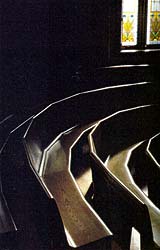
Original benches, refinished and regrained by skilled artisans, reflect meticulous care taken to restore the Assembly Hall to its nineteenth-century warmth and elegance.
Brother Jones adds that “we did one more interesting thing. We put in a series of timed delays with our sound to create the illusion that all sound actually originates at the rostrum. We delay the sound from the underpew speaker for a few milliseconds, so that the sound coming from the talker actually arrives at exactly the same time as the sound from the speaker. This has the effect of making the listener (and the mind) think that the sound they hear really is coming from the talker’s mouth. It works extremely well.”
The system, says Brother Jones, is unique. “It’s not the only underpew system, but it’s the only system designed to bounce twice before it gets to the people.”
Brother Jones was responsible, too, for the acoustical design of the building. In the downstairs rooms, which include the three organ practice rooms, dressing and make-up rooms (which double for quiet rooms at stake conferences), and a small rehearsal room for choir sectional practices or small instrumental ensembles, the intent was “to break up all of the sound so that we wouldn’t have any unusual reflections or concentrations of energy. We made a lot of non-parallel surfaces and kept everything as hard as we could. The ceiling slopes, the floor is flat, the walls are all at different angles to each other. The rooms turned out to be superb for the purpose we intended.”
“What we did in the main part of the building acoustically,” he says, “was to remove all of the absorbing surfaces that had been put in over the years, to help with some of the difficult reflections that occurred because of the curved ceilings, which tend to cause echoes. Then we put in those hundreds of speakers to control the sources of sound energy.”
“You know,” he adds, “you only get a chance to do something that unusual once in your lifetime, and that was really my opportunity. It was a satisfying, delightful project for me to work on—and from everything we can tell, it’s going to be very usable.”
The building will most certainly be used. One of its most enthusiastic users will be Iain B. McKay, who, as cultural arts specialist on the General Activities Committee, oversees the Temple Square Concert Series. Inaugurated in June 1980 as part of the Sesquicentennial celebration, the weekly concerts have grown in stature and popularity. “This is the Church’s prestigious concert series,” says Brother McKay. “It’s a showcase of LDS talent, yet we also invite nonmembers to perform, from pianists to singers to chamber music. We’re using the best of our LDS professional artists, and we’re also introducing the cream of our young up-and-coming artists.”
The concerts have been presented in the North Visitor’s Center theater on Temple Square, with maximum seating of 500. The Assembly Hall will expand the audience capacity to 1400. An opening series will be presented when the Assembly Hall is available for use, likely sometime this spring. “This is an elegant facility,” says Brother McKay, “and we certainly have the talent to go with it.”
A plaque to be placed in the Assembly Hall will bear the inscription: “The year 1980 is our year of jubilee, the 150th anniversary of the organization of the Church. It is the year to renew the past and remember with gratitude the labors and contributions of those who have gone before. It is a year to expand our vision, to renew our efforts and to build for those who follow.” The plaque bears the names of the First Presidency at that time—Spencer W. Kimball, N. Eldon Tanner, and Marion G. Romney.
(The renovation and organ construction were originally scheduled for completion during the Sesquicentennial year, as wording on the plaque would suggest. However, the unexpected structural problems in the attic delayed the project considerably.)
Looking back over his years of acquaintance with the Assembly Hall, Jim McCrea makes some interesting observations. He first visited Temple Square—as a nonmember in the early 1940s. At that time, he recalls, “I was impressed by the temple, but to really appreciate a building, you must be able to experience the interior space as well as the exterior. The outside alone is not enough; you must relate to the total building. The buildings on Temple Square I remembered best were the Tabernacle and the Assembly Hall. You can see, then, how important our treatment of the Assembly Hall is to the missionary effort.”
He views his role in the project from an artist’s perspective. “An architect doesn’t have to know how to do everything; he should be like the director of a great symphony, orchestrating all the precious elements. And if everyone has the right attitude, you can’t lose.”
He cites an illustrative incident, said to have occurred in the life of master English architect Sir Christopher Wren (1632–1723). “Wren was supervising construction of St. Paul’s Cathedral in London, and one day went to the building site, where he asked a number of the workers what jobs they were performing. One said, ‘I’m a carpenter,’ another said, ‘I’m a stone mason,’ another answered, ‘I’m a bricklayer,’ and so on. Finally he came upon one worker, who, when asked what he was doing on this job, said, ‘I’m helping Sir Christopher Wren build a cathedral.’
“That’s what we’ve had here at the Assembly Hall. We’ve had many on this job who have felt the great importance of this building, and they have really done everything to make it just that way. We’ve had that same feeling on every part of the project—a real unity of thought and purpose.”
And now, it seems, the Assembly Hall on Temple Square is more than ready to begin its second century.
Photography by Eldon K. Linschoten